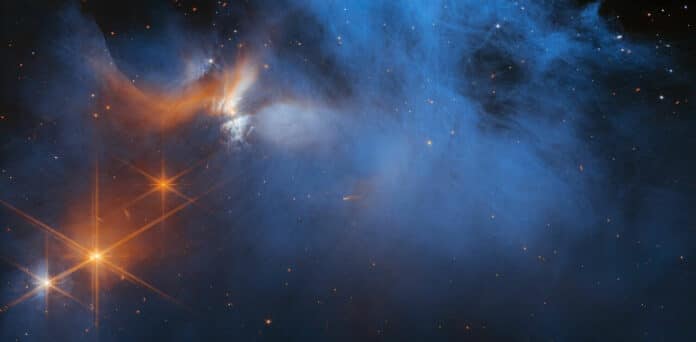Icy grain mantles are the main reservoir of the volatile elements that link chemical processes in dark, interstellar clouds with the formation of planets and the composition of their atmospheres. The initial ice composition is set in the cold, dense parts of molecular clouds before the onset of star formation.
Using observational data from the James Webb Space Telescope (JWST), an international team including Southwest Research Institute, Leiden University, and NASA has successfully achieved the darkest-ever view of a dense interstellar cloud.
Thanks to JWST’s 6.5-meter-wide mirror providing remarkable spatial resolution and sensitivity, optimized for infrared light, the telescope could capture the densest, darkest clouds in the universe for the first time.
These findings have provided fresh insights into the chemical processes of one of the coldest, darkest regions of the universe, as well as the origins of the molecules that make up planetary atmospheres by revealing the composition of a virtual treasure chest of ices from the early universe.
SwRI Research Scientist Dr. Danna Qasim, a study’s co-author, said, “The JWST allowed us to study ices that exist on dust grains within the darkest regions of interstellar molecular clouds. The clouds are so dense that these ices have been mostly protected from the harsh radiation of nearby stars, so they are quite pristine. These are the first ices to be formed and also contain biogenic elements, which are important to life.”
“These observations provide new insights into the chemical processes in one of the coldest, darkest places in the universe to better understand the molecular origins of protoplanetary disks, planetary atmospheres, and other Solar System objects.”
“Most interstellar ices contain very small amounts of elements like oxygen and sulfur. We seek to understand the lack of sulfur in interstellar ices.”
“The ices we observed only contain 1% of the sulfur we expect. 99% of that sulfur is locked up somewhere else, and we need to figure out where to understand how sulfur will eventually be incorporated into the planets that may host life.”
Scientists also proposed that sulfur may be locked in reactive minerals like iron sulfide, which may react with ice to form the sulfur-bearing ice observed.
Qasim said, “Iron sulfide is a highly reactive mineral that has been detected in the accretion disks of young stars and samples returned from comets. It’s also the most common sulfide mineral in lunar rocks.”
“If sulfur is locked up in these minerals, that could explain the low amount of sulfur in interstellar ices, which has implications for where sulfur is stored in our Solar System. For example, the atmosphere of Venus has sulfur-containing molecules, in which the sulfur could have partially come from interstellar-inherited minerals.”
Journal Reference:
- McClure, M.K., Rocha, W.R.M., Pontoppidan, K.M. et al. An Ice Age JWST inventory of dense molecular cloud ices. Nat Astron (2023). DOI: 10.1038/s41550-022-01875-w
